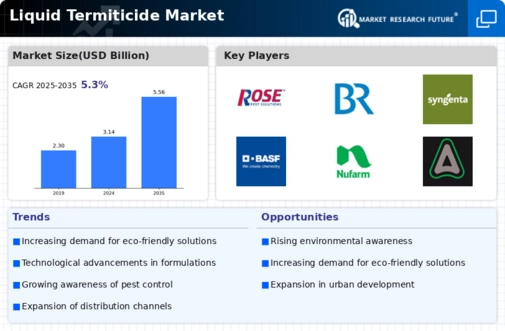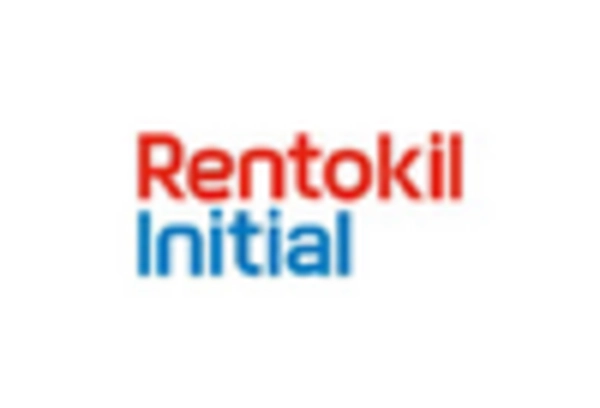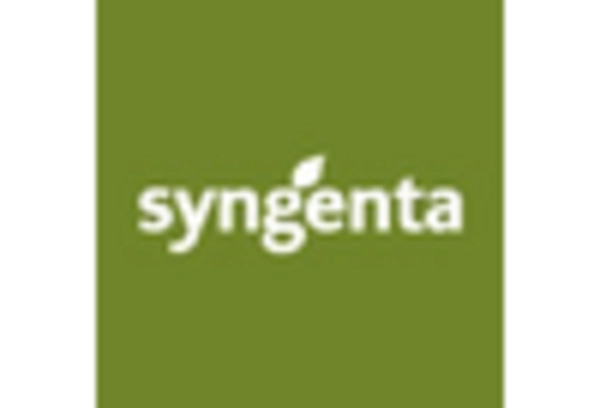Increased Construction Activities
The resurgence of construction activities across various sectors is driving demand within the Liquid Termiticide Market. As new residential and commercial buildings are erected, the need for effective termite protection becomes paramount. Data suggests that the construction industry is experiencing steady growth, with significant investments in infrastructure and housing projects. This trend is particularly evident in regions where termite infestations are prevalent, prompting builders and contractors to incorporate liquid termiticides into their construction practices. By integrating these solutions during the building phase, stakeholders aim to mitigate future risks associated with termite damage. Consequently, the Liquid Termiticide Market is poised for expansion as construction activities continue to rise, creating a favorable environment for pest control solutions.
Technological Innovations in Formulations
Technological advancements in the formulation of liquid termiticides are significantly influencing the Liquid Termiticide Market. Innovations such as microencapsulation and controlled-release technologies are enhancing the efficacy and longevity of these products. These advancements not only improve the performance of termiticides but also reduce environmental impact, aligning with the growing demand for sustainable pest control solutions. Market data indicates that products utilizing these technologies are gaining traction among consumers, as they offer prolonged protection against termite infestations. Additionally, the development of new active ingredients is expanding the range of options available to consumers, further stimulating market growth. As these technologies continue to evolve, the Liquid Termiticide Market is likely to witness increased competition and product differentiation.
Regulatory Support for Pest Control Solutions
Regulatory frameworks supporting pest control solutions are playing a crucial role in shaping the Liquid Termiticide Market. Governments are increasingly recognizing the importance of effective pest management in safeguarding public health and property. As a result, there is a growing emphasis on the approval and registration of liquid termiticides that meet safety and efficacy standards. This regulatory support not only enhances consumer confidence but also encourages manufacturers to invest in research and development of innovative products. Market data indicates that regions with stringent pest control regulations are witnessing a surge in the adoption of liquid termiticides, as compliance becomes a priority for pest control professionals. Thus, the Liquid Termiticide Market is likely to benefit from ongoing regulatory initiatives aimed at promoting effective pest management.
Rising Awareness of Termite Infestation Risks
The increasing awareness regarding the risks associated with termite infestations appears to be a primary driver for the Liquid Termiticide Market. Homeowners and property managers are becoming more cognizant of the potential damage termites can inflict, which can lead to costly repairs. According to recent estimates, termite damage costs property owners billions annually, prompting a surge in demand for effective pest control solutions. This heightened awareness is likely to drive investments in liquid termiticides, as consumers seek reliable methods to protect their properties. Furthermore, educational campaigns by pest control companies and government agencies are contributing to this trend, emphasizing the importance of preventive measures. As a result, the Liquid Termiticide Market is expected to experience robust growth as more individuals prioritize termite prevention.
Growing Demand for Preventive Pest Control Measures
The increasing demand for preventive pest control measures is emerging as a significant driver for the Liquid Termiticide Market. Consumers are shifting their focus from reactive to proactive approaches in managing pest infestations, particularly termites. This trend is fueled by the understanding that prevention is often more cost-effective than remediation after an infestation occurs. Market Research Future indicates that homeowners are more inclined to invest in liquid termiticides as part of their regular maintenance routines, recognizing the long-term benefits of such measures. Additionally, the rise of integrated pest management strategies is further promoting the use of liquid termiticides as a preventive tool. As awareness of the importance of early intervention grows, the Liquid Termiticide Market is expected to thrive, catering to the evolving preferences of consumers.


















Leave a Comment